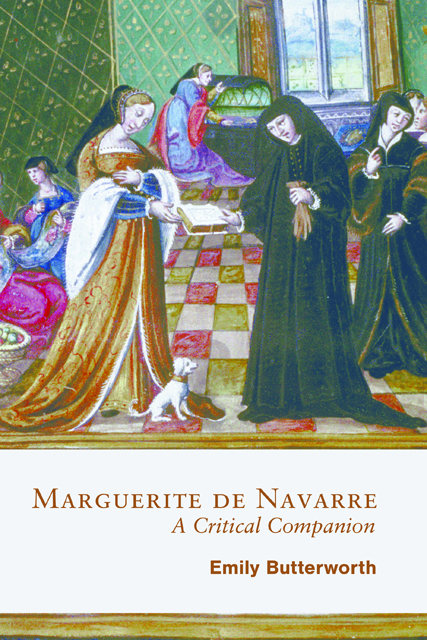Book contents
- Frontmatter
- Dedication
- Contents
- List of Illustrations
- Acknowledgements
- Note on Names and Editions
- Editions of Reference
- Introduction: A Brief Literary and Historical Chronology
- 1 Communities
- 2 Religion
- 3 Politics
- 4 Women and Men
- 5 Desire
- 6 Form and Technique
- Conclusion: Print and Public
- Bibliography
- Index
Introduction: A Brief Literary and Historical Chronology
Published online by Cambridge University Press: 20 December 2023
- Frontmatter
- Dedication
- Contents
- List of Illustrations
- Acknowledgements
- Note on Names and Editions
- Editions of Reference
- Introduction: A Brief Literary and Historical Chronology
- 1 Communities
- 2 Religion
- 3 Politics
- 4 Women and Men
- 5 Desire
- 6 Form and Technique
- Conclusion: Print and Public
- Bibliography
- Index
Summary
The life and writing of Marguerite de Navarre (1492–1549) bear witness to a troubled but exciting period of French and European history. A powerful and prominent political player through her brother, François I, and in her own right as a peer of the realm and queen of Navarre, Marguerite was at the heart of French diplomacy, religious controversy, and intellectual culture throughout her life. She wrote prolifically and fluently in a wide range of genres including devotional poetry, theatre, verse epistles, spiritual songs, short stories, diplomatic despatches, and political letters; some destined for print publication, some for more limited publics. She witnessed the flourishing of arts, culture, and learning, as the ideas and practices of the Renaissance took hold throughout Europe, and the critique of the established church which became the Reformation, bringing both renewed spirituality and bitter conflict. To a certain extent, these labels – ‘Renaissance’ and ‘Reformation’ – are later attempts to make sense of a history that was experienced as unpredictable and unresolved by people living through it. But they do help us to understand the important changes and concerns of the early sixteenth century, and this Introduction will provide a brief guide to the key dates of Marguerite’s life and how her work fits into a wider cultural, religious, and political history, an account that will be elaborated, developed, and nuanced in subsequent chapters.
The Renaissance is the term given to the period from around 1450–1600 in Italy and 1500–1600 elsewhere in Europe. It was a period of exceptional cultural and social development and change, in which the scholars involved saw themselves remaking European knowledge. The ‘Renaissance’ itself refers to the ‘rebirth’ of classical learning and knowledge that began in Italy and spread throughout Europe, thanks in large part to the Greek scholars who fled Constantinople after it was conquered by the Ottoman Empire in 1453. They brought with them previously unknown or forgotten texts of classical Greece which then entered circulation in European intellectual networks. Scholars associated with the Renaissance are known as humanists for their emphasis on the humanities – rhetoric, grammar, history, poetry, moral philosophy – and their insistence on a return to the sources both of classical learning and of theological teaching.
- Type
- Chapter
- Information
- Marguerite de NavarreA Critical Companion, pp. 1 - 9Publisher: Boydell & BrewerPrint publication year: 2022

